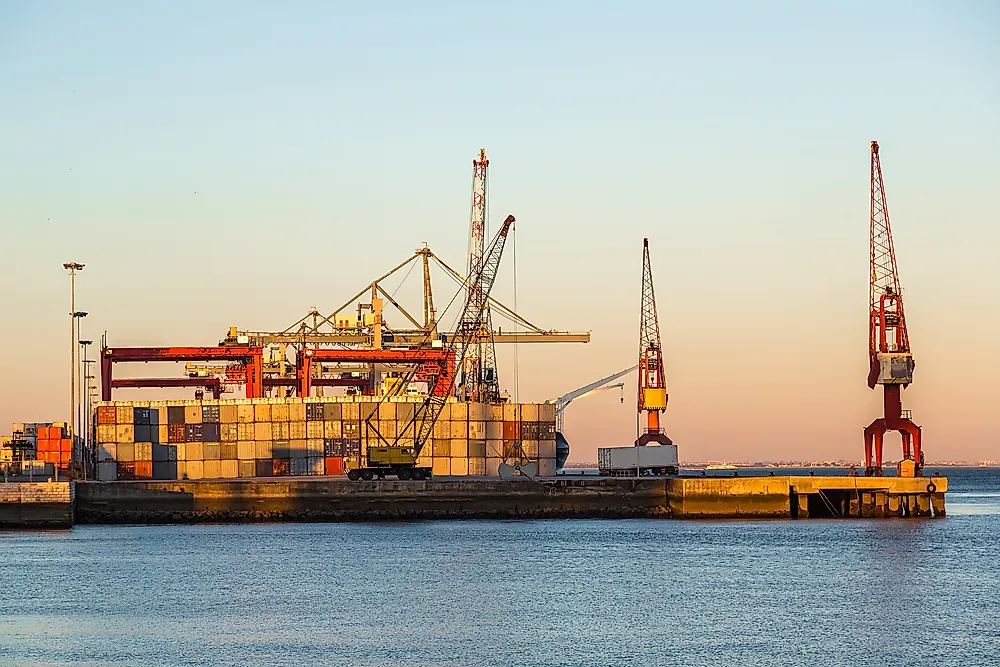The Biggest Industries In Portugal

Portugal is located to the west of Spain on the Iberian Peninsula, where it is a member of the European Union. This country has a gross domestic product (GDP) of $205.86 billion that when adjusted for purchasing power parity is equal to $310.651 billion. With a total population size of over 10.37 million, the average GDP per person (when adjusted for purchasing power parity) is $30,192. The total labor force here is only 5.2 million, a number that has been decreasing recently as unemployed individuals leave to look for employment opportunity elsewhere. As of 2012, just after the global economic crisis, approximately 45.4% of the population of Portugal was at risk of poverty. This number was inflated, however, by the high percentage of unemployment in this country at that time.
The economy of Portugal has bounced back since the global economic crisis and is now reporting an annual growth in GDP of 1.5%. This country exports a total of $54.7 billion worth of goods on an annual basis, making it the 40th largest export economy in the world. Additionally, it imports approximately $67.1 billion, giving Portugal a trade deficit of $12.4 billion.
This economy here once relied heavily on the manufacturing (also known as industry sector), although today it is moving more towards the services sector. For example, the majority of the working residents in this country are employed by the services sector (69.1%). This sector is followed by industry (24.5%) and agriculture (2.4%). Within the industry sector, corporations operating in this country tend to produce the following goods: machinery, automotive and ship parts, textiles, refined oil goods, plastics, food products, and beverages.
History of the Industry Sector
As previously mentioned, the industry sector employs nearly one-quarter of the labor force in Portugal, making it the second largest sector of the economy.
In the mid-1970’s, the industry and manufacturing industry in Portugal was at its most productive, contributing 35% of the national GDP. During the late 1980’s, this sector focused primarily on the production of refined sugar (with 285,900 metric tons produced), chemical fertilizers (with 1.3 million metric tons produced), steel goods (with 386,900 metric tons produced), and packaged sardines (with 27,400 metric tons produced). By the 1990’s, the economy in Portugal had shifted to electronics, automobile parts, and plastic goods. During this decade, the industry sector grew by around 3.1%, an above average growth rate. Economists have explained this growth by pointing to the government policies of the time, which worked to promote direct foreign investment. This goal was accomplished by offering subsidies to investors and privatizing industries that were previously owned by the state. Not all of this growth due to foreign investment was sustained over the long term, however. In just 5 short years (from 1995 to 2000), both the Ford and Renault automobile manufacturing plants closed down.
At the same time that the industry sector in Portugal was losing its automobile manufacturing plants, it was also struggling to stay competitive with the market in Asia. Its textiles industry, including clothing and shoes, was also drastically reduced in the latter half of the 1990’s. Economists believe that government policies to devalue the currency in Asia, along with the much lower salaries there worked against the manufacturing industry in Portugal.
The Industry Sector Today
Despite losing a few automobile factories in the late 1990’s, Portugal continues to produce a number of cars and car parts today. Factories focused on automobile and automobile parts production are primarily concentrated in and around the cities of Lisbon, Porto, Setubal, Braga, and Aveiro. As the manufacturing industry becomes increasingly competitive around the globe, investors and business owners in Portugal have turned toward more technology-based products. Goods like computer software and pharmaceutical products are now also being produced with factories primarily located in the cities of Oeiras and Coimbra. Other more modern industrial products being manufactured in Portugal today include the following industries: information technology, biotechnology, and aerospace technology.
The Export Economy
As previously mentioned, Portugal has the 40th largest export economy in the world. The top destination countries for exported goods from Portugal include Spain ($14.6 billion), France ($7.01 billion), Germany ($6.48 billion), the UK ($3.92 billion), and the US ($2.73 billion).
Exported products can be organized by specific category to have a better idea of which sector within this industry is responsible for the most exports. Although the most widely exported product from Portugal is vehicle parts (4.9% of all exports, or $2.67 billion), the combined category of machine products actually constitutes the largest percentage of exports at an annual value of $8.44 billion. Specific goods exported from this category include insulated wires (1.4% of all exports), metal molds (1.3%), radio receivers (1.2%), and electric control boards (0.83%). The second largest combined category of exports is transportation-related goods at an annual value of $6.28 billion. Vehicle parts (the largest single exported good) are classified under this category. Cars make up the second largest exported good in this category at 3.6% of all exported products (with an annual value of $1.96 billion). Finally, the third largest export category for Portugal is textiles, which make up $5.6 billion of all exports. Within this category, the most commonly exported goods include knit t-shirts (1.7% of all exports), house linens (1%), and knit sweaters (0.66%).
The Import Economy
The top countries from which Portugal imports goods include: Spain ($20.1 billion), Germany ($8.92 billion), France ($5.05 billion), China ($4 billion), and Italy ($3.89 billion).
The largest category of imported goods is machinery at an annual value of $11.2 billion. Within this category, the most commonly imported products are computers (1.1% of all imports), broadcasting equipment (0.93%), and integrated circuits (0.82%). The second largest import category is cars. In fact, cars by themselves make up 6.7% of all imports at a value of $4.49 billion. This is followed by vehicle parts, which make up 3.6% of all imports at a value of $2.4 billion.











